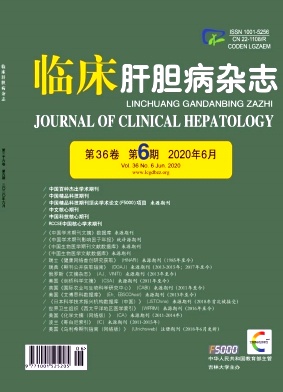Objective To investigate the association between nonalcoholic fatty liver disease( NAFLD) and colorectal adenomatous polyps and the correlation of NAFLD severity with the risk of colorectal adenomatous polyps. Methods A total of 67 patients with colorectal adenomatous polyps who were hospitalized in Department of Gastroenterology,The Second Affiliated Hospital of Kunming Medical University,from March to August 2019 were enrolled as adenoma group,and 45 patients who attended our hospital during the same period of time and had normal results of colonoscopy or were diagnosed with inflammatory and proliferative polyps based on pathology were enrolled as control group.The two groups were compared in terms of baseline data and controlled attenuation parameter( CAP) of the liver. All subjects were divided into non-fatty liver group and mild,moderate,and severe NAFLD groups according to FibroTouch,and the correlation of the severity of NAFLD with the risk of colorectal adenomatous polyps was analyzed. The t-test was used for comparison of normally distributed continuous data between two groups; a one-way analysis of variance was used for comparison between multiple groups,and the least significant difference t-test was used for further comparison between two groups. For non-normally distributed continuous data,the Mann-Whitney U test was used for comparison of non-normally distributed continuous data between two groups; the Kruskal-Wallis H test was used for comparison between multiple groups,and the Nemenyi method was used for further comparison between two groups. The chi-square test was used for comparison of categorical data between groups. A logistic regression analysis was used to investigate the risk factors for colorectal adenoma. Results Compared with the control group,the adenoma group had significantly higher proportion of male patients [49( 73. 13%) vs23( 51. 11%),χ2= 5. 687,P = 0. 017],age( 56. 24 ± 12. 44 years vs 50. 84 ± 11. 49 years,t =-2. 319,P = 0. 022),body mass index( BMI)( 24. 69 ± 3. 36 kg/m2 vs 22. 54 ± 3. 31 kg/m2,t =-3. 346,P = 0. 001),waist circumference( 89. 45 ± 10. 51 cm vs 83. 44 ±10. 30 cm,t =-2. 753,P = 0. 007),systolic pressure( 128. 78 ± 16. 92 mm Hg vs 117. 00 ± 15. 91 mm Hg,t =-3. 698,P < 0. 001),alanine aminotransferase( ALT) [24. 00( 18. 00 ~ 40. 00) U/L vs 22. 00( 16. 00 ~ 29. 00) U/L,Z =-1. 957,P = 0. 022 ],total cholesterol( TC)( 4. 73 ± 0. 96 mmol/L vs 4. 27 ± 0. 90 mmol/L,t =-2. 537,P = 0. 013),low-density lipoprotein( LDL)( 2. 92 ± 0. 78 mmol/L vs 2. 59 ± 0. 68 mmol/L,t =-2. 295,P = 0. 024),and CAP( 257. 51 ± 34. 22 d B/m vs 238. 67 ± 33. 44 d B/m,t =-2. 789,P= 0. 006). The logistic regression analysis showed that age( odds ratio [OR]= 1. 054,95% confidence interval [CI]: 1. 009-1. 102,P= 0. 019),BMI( OR = 1. 191,95% CI: 1. 026-1. 382,P = 0. 021),LDL( OR = 2. 058,95% CI: 1. 034-4. 097,P = 0. 040),ALT( OR = 1. 038,95% CI: 1. 008-1. 070,P = 0. 013),and CAP( OR = 1. 320,95% CI: 1. 163-1. 481,P = 0. 001) were independent risk factors for colorectal adenomatous polyps. The severe,moderate,and mild NAFLD groups had a significantly higher proportion of patients with colorectal adenomatous polyps than the non-fatty liver group [73. 08%( 19 patients)/73. 08%( 19 patients)/53. 85%( 14 patients) vs 40. 74%( 11 patients),χ2= 8. 088,P = 0. 040]. The logistic regression analysis showed that in the models 1 and 2,moderate NAFLD( model 1: OR = 1. 044,95% CI: 1. 007-1. 083,P = 0. 019; model 2: OR = 1. 011,95% CI: 1. 001-1. 022,P = 0. 033) and severe NAFLD( model 1: OR = 1. 183,95% CI: 1. 034-1. 354,P = 0. 015; model 2: OR = 1. 129,95% CI: 1. 030-1. 236,P = 0. 009)were risk factors for colorectal adenomatous polyps. In model 3,after adjustment for age,sex,BMI,smoking history,hypertension,diabetes mellitus,uric acid,triglyceride,LDL,and ALT,severe NAFLD( OR = 1. 078,95% CI: 1. 023-1. 136,P = 0. 005) was still a risk factor for colorectal adenomatous polyps. Conclusion NAFLD is an independent risk factor for colorectal adenomatous polyps,and patients with higher severity of NAFLD tend to have a higher risk of colorectal adenomatous polyps. Therefore,NAFLD patients,especially those with severe NAFLD,should undergo regular colonoscopy for early identification and treatment of colorectal adenomatous polyps,so as to eventually reduce the incidence rate and mortality rate of colorectal tumor in China.







 DownLoad:
DownLoad: